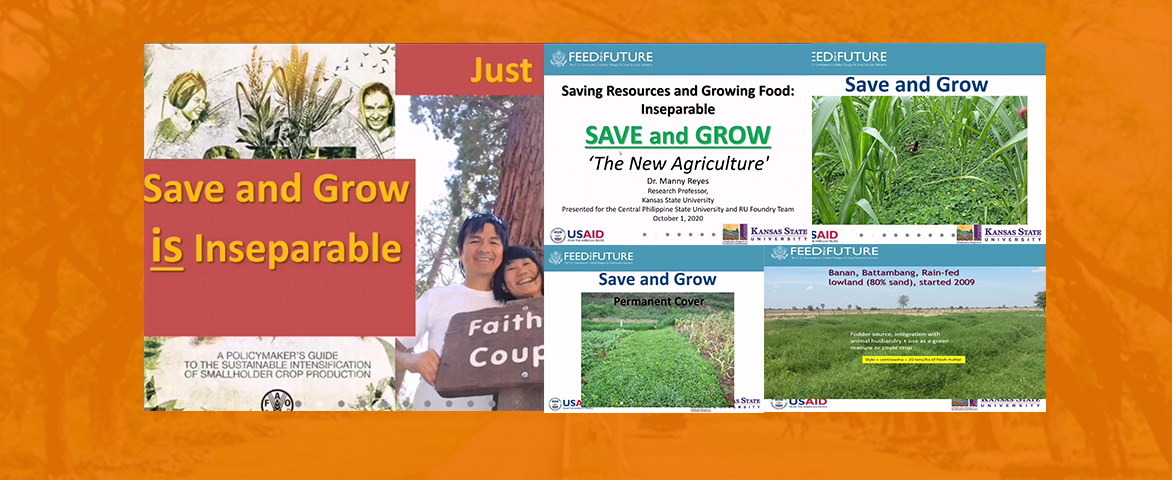By Josephine Asuncion R. Emoy
The University’s relentless endeavor in search for farming systems and practices that preserve and improve soil fertility while at the same time increasing crop production has finally been discovered through a revolution in the traditional farming practice known as Conservation Agriculture.
This innovation in agriculture was introduced to CPSU by Dr. Manny Reyes, research professor of Kansas State University in their partnership with USAID, through a webinar series which started last October 1, 2020. This was initiated through the efforts and leadership of Dr. Aladino Moraca, University President.
“This is the sure-win formula to solve the economic dilemma that our country is facing today. This farming system ensures stable supply of farm produce to answer issues on food security especially on rice sufficiency, and at the same time guarantees sustainable livelihood to our marginalized farmers,” Dr. Moraca stated.
The said webinar series (on going), set every Thursday of the week is attended by CPSU personnel coming from its various campuses, together Sir Ramon Uy, President of RU Foundry and Machine Shop as well as stakeholders, partner LGUs and NGOs, SUCs in Negros Island (which joined starting its fourth webinar schedule) such as Negros Oriental State University (NORSU), Carlos Hilado Memorial State College (CHMSC), Northern Negros State College of Science and Technology (NONESCOST), La Carlota City College (LCCC) along with other invited schools and organizations who also share the same eagerness in promoting innovations in sustainable agriculture.
Conservation Agriculture (CA) or “no till” farming is also known as regenerative agriculture that increases yield while enhancing soil heath. “It is done through three components, (a) minimum soil disturbance (permanent no till), (b) permanent organic soil cover, and (c) diversification of species in rotation, sequence or associations. If one is lacking, it could no longer be called Conservation Agriculture,” Sir Manny stated.
He further stressed that constant plowing disturbs and rubs the natural elements and compounds present in the soil. It is like stripping off the soil’s clothes resulting to depletion. In CA, the soil is regenerated through organic enhancers. Mulching is one way to fertilize the soil. Also, cover crops such as legumes, which produce organic nitrogen, are used as soil conditioner or fixer. Part of this process is diversification to maximize soil produce, which means planting various types of crops and plants in an allotted area. “Add residue to cover the soil regularly and don’t monocrop. Instead, diversify in species,” Sir Manny emphasized.
As a starter, he encouraged CPSU to make “legacy plots” or permanent areas that are not and will not be plowed. These areas will be regularly added with compost, and mulched with hay or straw to retain moisture, encourage development of good microorganisms and minimize if not eliminate weeds. This way, soil is enhanced and regenerated.
CA promotes the idea of SAVE & GROW, saving resources while at the same time, growing food. It is a new perspective in agriculture which teaches farmers and households not just to grow and grow, but also to save and enhance resources. “Conservation agriculture in commercial vegetable home gardens provide income to farmers, especially to women,” Sir Manny indicated.
Now, with the participation of other SUCs, disseminating this innovation to the community will be easier. “With the collaboration and commitment of other SUCs, like NORSU, CHMSC, NONESCOST an LCCC to push this new system in agriculture in the entire Negros Island, and in partnership with RU Foundry, the Department of Agriculture and the Office of the Provincial Agriculturist, this practice will help to fast-track the process of regaining economic stability especially in these drastic times,” Dr. Moraca stated.
This propitious farming innovation, the Conservation Agriculture, once introduced to the community and the farmers, promises better future not just to them, but to the local community, as well.

Photo by: Sir Manny Reyes










